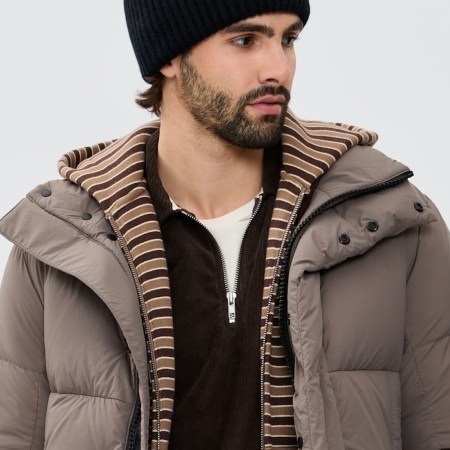As temps plummet and the sky grows dark, we have some advice: Go outside.
Do something radical. Like, say, climbing Everest.
That’s the philosophy behind Live Out There, a new direct-to-consumer brand that makes handsome outdoor apparel for the world’s most extreme conditions.
Co-founded by Jamie Clarke, a professional adventurer who’s scaled Everest (twice) along with the Seven Summits, Live Out There crafts adventure gear that’ll also scale just fine in city environs.
Their transparent, consumer-friendly business model should be familiar to InsideHook — it’s a favorite of brands like Warby Parker, Everlane, etc. Basically, you get quality wares with about 40 percent less markup because there are no retail middlemen taking a cut. So a great down hooded jacket goes for $170 instead of, say, $300.
Plus, their factories conform to the BSCI Code of Conduct, which is all about fair remuneration, occupational health and safety, no child labor and protection of the environment, all within the supply chain.
A few favorites from the newly launched line:
- The Denali Down Hooded Jacket, made from 100% 800+ fill traceable goose down
- The extremely lightweight Chamonix Down Jacket (see above), a layer so packable can stuff into its own pocket
- The Alps Down Vest, which keeps your core warm but your arms free to move about
- And the down-filled, waterproof Storm Down Parka, built to survive Camp 2 on Everest but also look good around the city during a winter storm (we saw it in person, and yep, it does the trick)
Which is great. But since we were in the presence of one of the world’s premier professional adventurers, we also wanted to know where to take this outerwear.
Clarke’s five places to adventure travel, in his own words, below:
1. Mt. Assiniboine Provincial Park (British Columbia, Canada)
“Mount Assiniboine is more impressive than the Matterhorn — with none of the crowds. Hike or ski in, or take a helicopter from Canmore, Alberta, and then regale in the wifi-less serenity. And this place is equally awesome in the heart of summer as it is in the the dead of winter. I’ve been traveling here in one way or another for 40 years. Spend the money and stay at the Lodge. Tell Claude (the curator and host) I sent you and he and his team will give you THE special treatment, including an invite to the private guide meeting.”
2. Everest Trek (Nepal)
“Don’t waste time visiting Everest’s base camp. You don’t want to see the climbers and they don’t want to see you. Instead, be sure to hike Kala Patar for sunrise. If the sky is clear, Sagarmatha will blow your mind.”
3. Machu Picchu (Peru)
“One of those rare places where the reality surpasses the imagination. But you have to go in on foot and not the train. It’s few days of easy hiking — a pilgrimage of sorts — with plenty of friendly support from the Peruvian guides. The hike finishes by waking at 4 a.m. for a stroll to the the Sun Gate. Breathe. Behold.”
4. BC Bike Race (British Columbia, Canada)
“If you’re any kind of mountain biker, do this race. But rather than killing yourself for a fast time, ride like a tourist. Enjoy a week of riding with full race support in arguably the greatest mountain biking terrain on the planet. My wife and I raced as a mixed couple and placed third. Though it was fun to stand on the podium, I wish we’d taken a more leisurely approach to better soak it all in.”
5. Red Rock Canyon (Las Vegas)
“America is one of my favorite places to visit for outdoor adventure. One of my favourites — and not just because I like to gamble and drink and eat — is Red Rocks, west of Las Vegas. Close to town, this is an outdoor wonderland 365 days a year. Hike, bike, trail run or simply go to walk off a hangover and a craps binge — I love this place even in the middle of July.”
As Clarke notes: “For all of these places …everyone’s day pack should have a light down jacket like our Chamonix or the Denali or at the least the Alps vest. Even Vegas in the summer. For safety, I never travel without a proper first-aid kit and a down layer. You never know when you might stay out longer than planned, and a warm layer helps when the sun is gone — even in the desert.”
This article appeared in an InsideHook newsletter. Sign up for free to get more on travel, wellness, style, drinking, and culture.
























